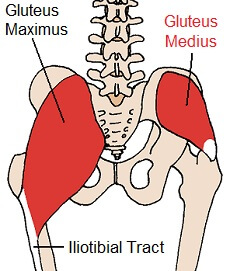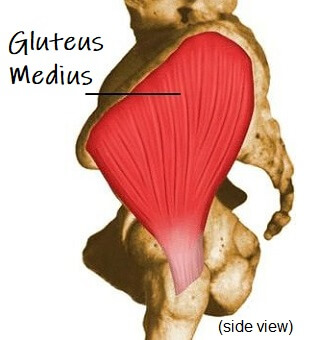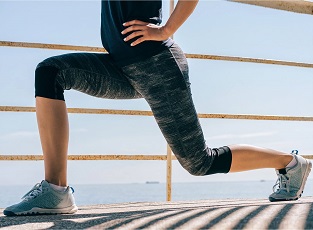- Home
- Knee Joint Anatomy
- Muscles
- Gluteus Medius
Gluteus Medius Muscle
Written By: Chloe Wilson, BSc(Hons) Physiotherapy
Reviewed by: KPE Medical Review Board
Gluteus medius is a broad, thick, radiating muscle found in the buttocks.
It sits on the upper, lateral part of the buttock, just below the iliac crest - if you place your hands on your hips, that’s the large bony area that your fingers rest on.
Gluteus medius is a fan-shaped muscle, wide at the top, narrow at the bottom and is found underneath the gluteus maximus muscle.
Origin & Insertion
Glute med arises from the gluteal surface of the ileum (part of the pelvis) between the anterior and posterior gluteal lines, an extensive area from the iliac crest above almost as far as the sciatic notch below, attaching via a strong layer of fascia of which it shares the posterior part with gluteus maximus.
Three sets of fibres spread out:
- anterior fibres passing downwards and backwards
- middle fibres passing straight downwards
- posterior fibres downwards and forwards
They then come together to form a flattened tendon which attaches to the superolateral side of the greater trochanter on the femur.
Function Of Gluteus Medius
Gluteus medius is a strong hip abductor, taking the thigh outwards away from the body. The anterior fibres contract to produce internal rotation (twisting the leg inwards) whereas the posterior fibres aid lateral rotation (twisting outwards).
Gluteus medius plays a vital role in the stability of the pelvis during walking and running. When walking, approximately 60% of the time we are standing on one leg, known as the stance phase of the gait cycle.
When standing on one leg, there is a tendency for the opposite side of the pelvis to drop due to the loss of support. Gluteus medius works hard on the supporting side to maintain a level pelvis so that the leg can be brought forwards for the next step.
Common Problems
Weakness in the gluteus medius muscle results in the pelvis dropping on the opposite side as you walk or run. It also helps to control hip and pelvic rotation during walking and running.
If gluteus medius is weak or isn’t functioning properly, people walk with what is called a Trendelenburg gait, where the opposite side of the pelvis drops with each step due to the last of support. Weakness in the left glute med muscle causes the right side of the pelvis to drop when swinging the right leg forwards when walking.
This can make walking awkward and people tend to compensate by swinging their trunk towards the weakened side to keep their pelvis level and their center of gravity over the standing leg so they can swing their leg through. Running is almost impossible.
If you have a problem with your gluteus medius, have a look at:
- Glutes Strengthening Exercises: Great exercises to target glute med to get back strength and stability
- Glute Stretches: Alleviate tightness in the glutes with these simple yet effective stretches
- Leg Muscles: Find out how the rest of the leg and knee muscles work together
Summary
Muscle Group: Gluteus Medius is one of the gluteal muscle
AKA: Glute Med
Action: Hip abduction, internal rotation (anterior fibres), external rotation (posterior fibres)
Origin: Lateral surface of the ilium from the iliac crest to the sciatic notch
Insertion: Superolateral side of the greater trochanter of the femur
Nerve Supply: Superior gluteal nerve (L4, L5, S1)
Functional Activities: Standing on one leg, walking, running
Other Knee Muscles
Related Articles
Resistance Band Exs
December 7, 2023
Diagnosis Chart
March 25, 2025
Improve Flexibility
September 30, 2025
Last Updated: November 26th, 2025
Next Review Due: November 26th, 2027







